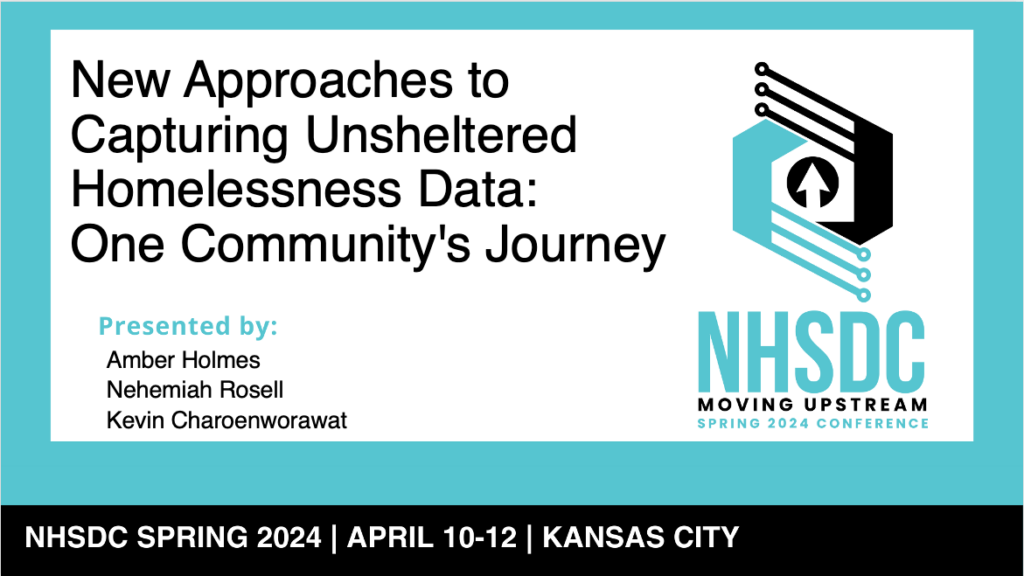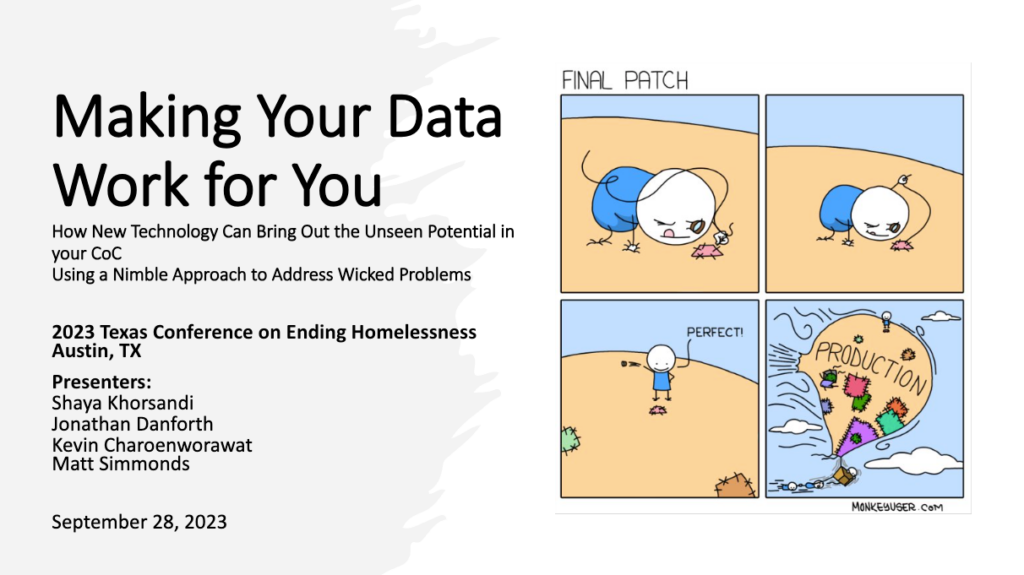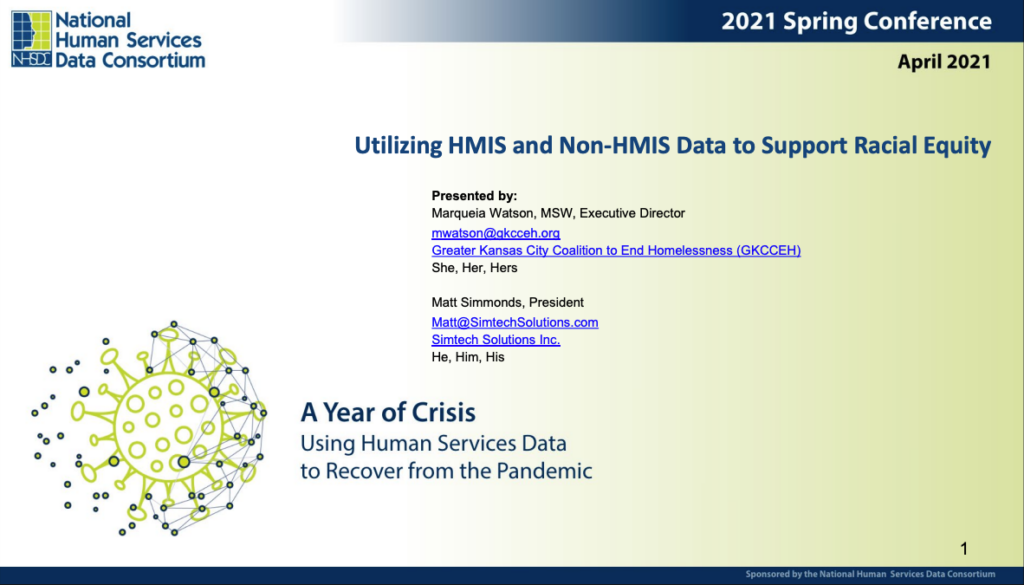New Approaches to Capturing Unsheltered Homelessness Data: One Community’s Journey
Presented at: NHSDC, Kansas City, MO
Presented on: 04/11/2024
This presentation delivered at the NHSDC conference in Kansas City detailed a comprehensive, community-led initiative to enhance the collection and use of data on unsheltered homelessness. The Kansas City team highlighted the limitations of traditional Homeless Management Information Systems (HMIS), particularly their ineffectiveness in field outreach and progressive engagement. In response, the community developed and deployed a mobile app tailored for street outreach, enabling real-time data collection, improved service coordination, and more accurate tracking of client needs and interactions. This person-centered tool fostered greater collaboration among outreach teams, government agencies, and service providers, ultimately laying the groundwork for a shared data infrastructure that supports informed decision-making and equitable resource allocation.
The presentation further explored challenges encountered throughout the initiative, such as data privacy concerns, stakeholder buy-in, and the need for cultural shifts within agencies. Despite these hurdles, the implementation showed significant improvements in data quality, outreach efficiency, and interagency communication. The speakers emphasized the importance of continued community engagement, policy alignment, and cross-departmental collaboration to sustain progress. Kansas City’s experience serves as a model for other jurisdictions seeking to modernize their data systems and address homelessness with greater responsiveness and equity. The initiative underscores how thoughtful integration of technology and human services can drive meaningful systemic change.

Making Your Data Work For You
Presented at: Texas Conference on Ending Homelessness, Austin, TX
Presented on: 09/28/2023
The 2023 THN Data Presentation, delivered at the Texas Conference on Ending Homelessness, explores how technology and agile methodologies can unlock hidden potential within Continuums of Care (CoCs). The presentation focuses on improving service delivery by rethinking problem statements and leveraging data standards to better track homelessness trends. One highlighted case study involves intake phone lines, where up to one-third of calls were found to be inappropriate for the services offered. The team developed a more efficient call triage and assessment system using decision trees and call data analysis to better route inquiries and reduce staff burden, ultimately enhancing access to care and resource prioritization.
The presentation further details innovations in housing pipeline management and feedback loop design. Through process mapping and stakeholder collaboration, particularly with organizations like Connective, the team introduced a more automated, data-driven approach that minimized manual processing and allowed for greater scalability. These improvements led to a dramatic reduction in bureaucratic steps and wait times for housing, citing an example where wait time for homeless veterans dropped from 720 days to just 32. The overarching goal was to empower local systems to respond more nimbly and equitably to homelessness by integrating user-centered design, rapid prototyping, and real-time data feedback mechanisms.

Understanding the Importance of (and Best Practices For) Your Unsheltered Point-in-Time Count
Presented at: NAEH
Presented on: 02/11/2022
The Point-in-Time Count provides an important snapshot on the state of homelessness in America. This workshop will highlight the issues related to an incomplete picture of unsheltered homelessness from 2021. It will also explore successful approaches used to conduct 2022’s unsheltered count in various geographic regions, including the adoption of mobile technology.
Utilizing HMIS and non-HMIS Data to Support Racial Equity
Presented at: NHSDC
Presented on: 04/26/2021
Kansas City, MS is a melting pot that consists of people of all forms of race, culture, and socioeconomic background. Unfortunately, we live in a society where not all people are treated equitably. In this session, we will provide an overview of the tools and resources that we are using to evaluate potential disparities in outcomes so that we can lean in on the policies and practices to address any inequities that are uncovered. The data sets to be used for our analysis include geospatial data from the US Census, as well as GPS-enabled data gathered by volunteers during the annual homeless census and the ongoing data collection of street outreach. During this session we will also discuss the actions that are being taken to utilize the findings to help ensure we that our community’s response to homelessness is an equitable one.

Supporting People Experiencing Homelessness During Natural Disasters & COVID with Mobile Tech
Presented at: Good Tech Fest
Presented on: 05/20/2020
Rapidly deployed GPS-enabled surveying tools, and the understanding that can be derived with the aid of geospatial reporting, can play a key role in providing targeted assistance to those in need.
Back in 2012, while wrapping up the counts for the cities of Quincy and Brockton, MA, we decided it was time to make the move to mobile tech. The US Department of Housing and Urban Development (HUD) recognized the viability of this early work by licensing the “Point in Time Counting Tool” app from Simtech and subsequently contracted with us to enhance it even further. Simtech has built upon this work with HUD through the release of the Counting Us mobile app and the Point in Time Regional Command Center that it is integrated with. Our tools are now helping regions throughout the country to automate their annual point in time counts.
In addition to supporting automated PIT counts in forty-seven (47) regions across the US in 2019, the technology has also been used to support a rapid-response to natural disasters and Covid. For example, Texas Balance of State and Houston were able to quickly deploy the app to help triage over two-thousand people who had become homeless due to the flooding as a result of hurricane Harvey. Using this tech, volunteers and first responders in regions without internet access are able to still complete geo-tagged surveys and submit them when the user comes back online. This enables this vital data capture to still continue even during times when the entire grid is offline.
It is our hope that by sharing this work that we can propel the discussions forward on the steps that need to be taken to deploy technologies that will enable our communities to more readily respond to crisis – whether the crisis takes the form of the slow progression of economic inequality or the fast-paced destruction of hurricanes or wildfires.
Tools and Support for Local COVID-19 Response
Presented at: NAEH
Presented on: 04/21/2020
Mobile Technology is a valuable tool in local emergency responses to the novel coronavirus (COVID-19). This presentation details tools available from Simtech Solutions and how they can be applied to improve efforts to support Shelter-in-Place, tracking resource needs and allocation, conducting health screenings, and more! Examples of communities using these tools are provided, including San Diego and Gulfport, MS. Geo-spatial, customized surveys that follow CDC Guidance are helpful for drilling down into specific, local needs and quickly identify both gaps and solutions.
